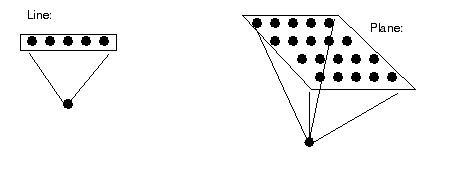
Kohonon's SOMs are a type of unsupervised learning. The goal is to discover some underlying structure of the data. However, the kind of structure we are looking for is very different than, say, PCA or vector quantization.
Kohonen's SOM is called a topology-preserving map because there is a topological structure imposed on the nodes in the network. A topological map is simply a mapping that preserves neighborhood relations.
In the nets we have studied so far, we have ignored the geometrical arrangements of output nodes. Each node in a given layer has been identical in that each is connected with all of the nodes in the upper and/or lower layer. We are now going to take into consideration that physical arrangement of these nodes. Nodes that are "close" together are going to interact differently than nodes that are "far" apart.
What do we mean by "close" and "far"? We can think of organizing the output nodes in a line or in a planar configuration.

E.g. if x1 and x2 are two input vectors and t1 and t2 are the locations of the corresponding winning output nodes, then t1 and t2 should be close if x1 and x2 are similar. A network that performs this kind of mapping is called a feature map.
In the brain, neurons tend to cluster in groups. The connections within the group are much greater than the connections with the neurons outside of the group. Kohonen's network tries to mimick this in a simple way.
- Randomly choose an input vector x
- Determine the "winning" output node i, where wi is the weight vector connecting the inputs to output node i.
Note: the above equation is equivalent to wi x >= wk x only if the weights are normalized.
- Given the winning node i, the weight update is
where ![]() is called the
neighborhood function that has value 1 when i=k and falls off with the distance |rk - ri
| between units i and k in the output array. Thus, units close to the winner as well as the winner itself, have
their weights updated appreciably. Weights associated with far away output nodes do not change significantly. It
is here that the toplogical information is supplied. Nearby units receive similar updates and thus end up responding
to nearby input patterns.
is called the
neighborhood function that has value 1 when i=k and falls off with the distance |rk - ri
| between units i and k in the output array. Thus, units close to the winner as well as the winner itself, have
their weights updated appreciably. Weights associated with far away output nodes do not change significantly. It
is here that the toplogical information is supplied. Nearby units receive similar updates and thus end up responding
to nearby input patterns.
The above rule drags the weight vector wi and the weights of nearby units towards the input x.


where s2 is the width parameter that can gradually be decreased over time.